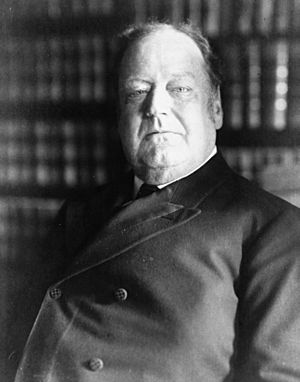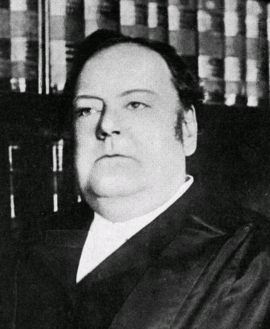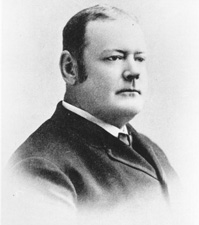Edward Douglass White facts for kids
Quick facts for kids
Edward Douglass White
|
|
|---|---|

White in 1905
|
|
| 9th Chief Justice of the United States | |
| In office December 19, 1910 – May 19, 1921 |
|
| Nominated by | William Howard Taft |
| Preceded by | Melville Fuller |
| Succeeded by | William Howard Taft |
| Associate Justice of the Supreme Court of the United States | |
| In office March 12, 1894 – December 18, 1910 |
|
| Nominated by | Grover Cleveland |
| Preceded by | Samuel Blatchford |
| Succeeded by | Willis Van Devanter |
| United States Senator from Louisiana |
|
| In office March 4, 1891 – March 12, 1894 |
|
| Preceded by | James Eustis |
| Succeeded by | Newton Blanchard |
| Justice of the Louisiana Supreme Court | |
| In office January 1879 – April 1880 |
|
| Nominated by | Francis T. Nicholls |
| Preceded by | William B. Giles Egan |
| Personal details | |
| Born |
Edward Douglass White Jr.
November 3, 1845 Thibodaux, Louisiana |
| Died | May 19, 1921 (aged 75) Washington, D.C. |
| Resting place | Oak Hill Cemetery |
| Political party | Democratic |
| Spouse |
Leita Montgomery Kent
(m. 1894) |
| Education | Mount St. Mary's University (AB) Georgetown University (no degree) Tulane University (LLB) |
| Signature | |
Edward Douglass White Jr. (born November 3, 1845 – died May 19, 1921) was an important American politician and judge from Louisiana. He served on the U.S. Supreme Court for 27 years. First, he was an associate justice from 1894 to 1910. Then, he became the ninth chief justice from 1910 until his death in 1921. White is well-known for creating the Rule of Reason standard in antitrust law. This rule helps decide if business practices are fair or unfair.
Born in Lafourche Parish, Louisiana, White studied law and became a lawyer in New Orleans. His father, Edward Douglass White Sr., was a former Governor of Louisiana and a U.S. Representative. During the Civil War, White fought for the Confederacy. After the war, he was elected to the Louisiana State Senate and served on the Louisiana Supreme Court. As a member of the Democratic Party, White represented Louisiana in the United States Senate from 1891 to 1894.
In 1894, President Grover Cleveland chose White to be an associate justice on the Supreme Court. Later, in 1910, President William Howard Taft made him the chief justice. This was a surprise because Taft was from a different political party. White stayed as chief justice until he passed away in 1921. Taft then took his place.
White was part of the Supreme Court's decision in Plessy v. Ferguson. This case said that segregation (keeping people of different races separate) was legal if facilities were "separate but equal". He also wrote the court's decision in Guinn v. United States. This decision struck down "grandfather clauses" that stopped African-American people from voting. He also wrote the opinion in the Selective Draft Law Cases, which said that conscription (the draft) was allowed by the Constitution.
Contents
Early Life and Education
Edward Douglass White Jr. was born on November 3, 1845. His family lived on a sugar plantation near Thibodaux, Louisiana. This home is now a state park. His father, Edward Douglass White Sr., was a lawyer and judge. He had also been a U.S. Representative and the governor of Louisiana. White's mother was Catherine Sidney Lee Ringgold. She came from an important family in Washington, D.C..
White's father died in 1847, when Edward was very young. In 1850, his mother remarried, and the family moved to New Orleans. Edward started attending a Jesuit school in New Orleans at age six. Later, he went to Mount St. Mary's College in Maryland. In 1858, he enrolled at Georgetown University. This was a top Catholic school. White's Jesuit training helped shape his legal thinking. He learned to focus on clear, logical reasoning. He studied classic subjects and played music. He also joined the school's cadet corps. When the American Civil War began, White left Georgetown and returned home.
Joining the Confederate Army
White's studies were stopped by the Civil War. It is believed that he returned to Louisiana and joined the Confederate States Army. He may have served under General Richard Taylor. Some accounts suggest he reached the rank of lieutenant.
One story says White almost got caught by Union troops in 1862. He supposedly hid under hay in a barn. Another account suggests he was an aide to Confederate General William Beall. He may have been with him at Port Hudson, Louisiana, during a siege in 1863. However, White's name is not on any list of prisoners captured there.
The only clear proof of White's service is his capture on March 12, 1865. This happened in Morganza, in Pointe Coupee Parish. His service records in the National Archives confirm this. They show he was a lieutenant in a Louisiana cavalry unit. He was held prisoner in New Orleans and then released in April 1865.
White was one of three former Confederate soldiers to serve on the Supreme Court. The others were Associate Justices Lucius Quintus Cincinnatus Lamar and Horace Harmon Lurton.
Political Career
After the Civil War, White began studying law. He attended the University of Louisiana in New Orleans. This school is now known as the Tulane University Law School. He became a lawyer in New Orleans in 1868. A well-known New Orleans lawyer, Edouard Bermudez, helped him early in his career. Bermudez later became chief justice of the Louisiana Supreme Court.
White served in the Louisiana State Senate in 1874. He also served on the Louisiana Supreme Court from 1878 to 1880. In 1891, the Louisiana State Legislature elected him to the United States Senate. He worked closely with two-time governor Francis T. Nicholls. White managed Nicholls' campaign in the 1888 election.
United States Supreme Court
Becoming an Associate Justice
President Grover Cleveland nominated Edward White to be an associate justice on February 19, 1894. The Senate quickly approved his nomination the same day. He officially started his role on March 12, 1894.
In 1896, White was part of the majority decision in Plessy v. Ferguson. This case decided that racial segregation laws were constitutional. It said that public facilities could be separate for different races as long as they were "equal in quality."
Serving as Chief Justice

On December 12, 1910, President William Howard Taft nominated White to become Chief Justice of the United States. This was after the death of Chief Justice Melville Fuller. It was unusual because White was already an associate justice. The Senate approved his nomination on the same day. He became the ninth chief justice on December 19, 1910.
White was generally seen as a conservative member of the court. He created the term "Rule of Reason" in antitrust cases. He also joined the Hammer v. Dagenhart decision, which ruled that the federal government could not ban child labor. However, White also wrote the decision in 1916 that supported the Adamson Act. This law set an eight-hour work day for railroad employees.
Even though White was from the South and a former Confederate, he often supported stronger federal power in his decisions. He wrote the decision for a unanimous court in Guinn v. United States (1915). This case made "grandfather clauses" illegal. These clauses were used in Southern states to stop African Americans from voting. However, Southern states soon found other ways to limit voting rights.
In 1918, the Selective Draft Law Cases supported the Selective Service Act of 1917. This decision upheld the legality of conscription in the United States (the draft).
During his time as chief justice, White swore in presidents Woodrow Wilson (twice) and Warren G. Harding. He died on May 19, 1921, at age 75. He had served on the Supreme Court for 27 years, with 10 of those years as chief justice. Former president Taft, who had made White chief justice, succeeded him.
Personal Life and Death
Edward White married Leita Montgomery Kent on November 6, 1894, in New York City. She was a widow. White had proposed to her before her first marriage, but she had turned him down. He proposed again after her first husband died.
White's family background was Irish Catholic. He was raised as a Roman Catholic and remained one his entire life.
White passed away on May 19, 1921. He is buried at the Oak Hill Cemetery in Washington, D.C..
Legacy and Honors
- In 1914, he received the Laetare Medal from the University of Notre Dame. This is a very important award for American Catholics.
- A statue of White is in the National Statuary Hall in the U.S. Capitol. It honors Louisiana natives.
- Another statue of White was in front of the Louisiana Supreme Court building in New Orleans. It was removed in December 2020.
- The Louisiana State University Law Center holds annual Edward Douglass White Lectures in his honor.
- A play about his life, Father Chief Justice: Edward Douglass White and the Constitution, was written by Paul Baier.
- In 1995, White was added to the Louisiana Political Museum and Hall of Fame.
- Several Knights of Columbus councils were named after him.
- Edward Douglas White Catholic High School in Thibodaux, Louisiana, is named for him.
- During World War II, a Liberty ship called SS Edward D. White was built in his honor.
Images for kids
See also
 In Spanish: Edward Douglass White para niños
In Spanish: Edward Douglass White para niños
- List of justices of the Supreme Court of the United States
- List of United States Supreme Court justices by time in office
- United States Supreme Court cases during the White Court





